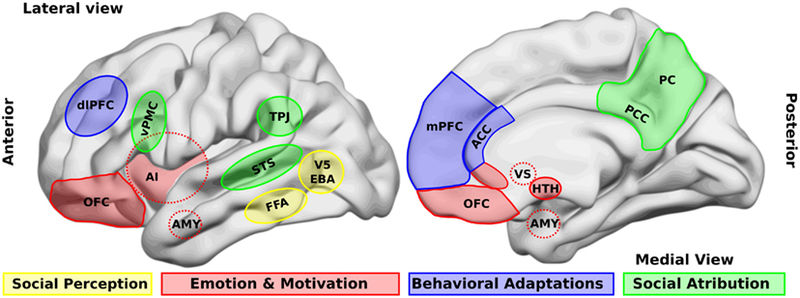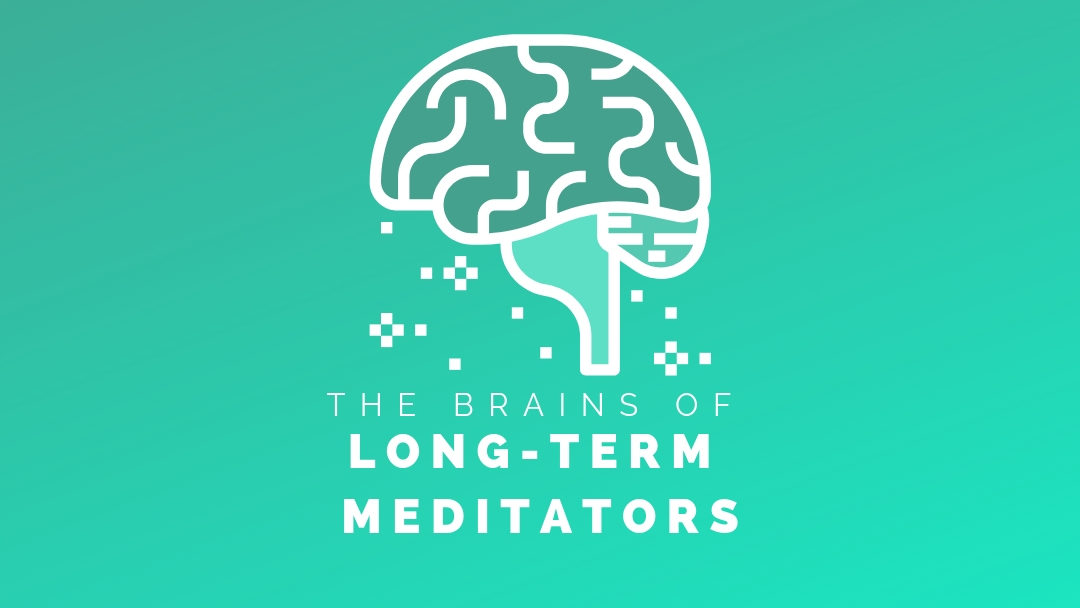There’s something incredible about the brains of long-term meditators
When I talk about long-term meditators, I’m referring to people with 10,000 hours+ of practice.
I, myself, am in the thousands of hours, but I have a few years to go at an hour or an hour and a half a day before I reach 10K.
That said, I am really fascinated by the brains of long-term meditators. There are some incredible things that happen. It makes me want to get an MRI just to see what’s going on in my own head.
Brain structures change with long-term meditators

Amygdala = AMY; anterior insula = AI; anterior cingulate cortex = ACC; orbitofrontal cortex = OFC. Other structures: medial prefrontal cortex = dlPFC, mPFC; anterior cingulate cortex = ACC; posterior cingulate cortex = PCC and the precuneus (PC) participate in more automatic, bottom-up inferences of other people’s mental states; whereas structures like the mPFC and the temporo-parietal junction (TPJ) are involved in more cognitive theory of mind skills.
Photo credit: Billeke P and Aboitiz F [CC BY 3.0], via Wikimedia Commons
Amygdala
This structure is located toward the lower part of the brain. It’s associated with the fight or flight stress response. It shrinks markedly in long-term meditators such that reactivity to positive or negative stimuli is greatly reduced.
For me, personally, I still feel stress, even as a medium-term meditator. But I can tell it has a much-reduced impact on my life. More and more people have started to tell me that I almost always seem happy and calm.
Posterior cingulate
This structure has an anterior and posterior section in the brain. Both are affected by meditation insofar as they grow thicker, especially the anterior cingulate, with regular meditation.
This is the part of the brain that affects mind-wandering and plays a role in emotion regulation. It plays a role in self-consciousness, as well as social awareness.
Pre-frontal cortex
This brain structure helps with learning new things and memory. It naturally shrinks as people get older. However, in long-term meditators, the opposite happens! People with 10,000 hours of meditation have brains that are younger than people of the same age.
Folks who are 50 years old and have meditated 10,000 hours, have brains that look like 25 year olds according to MRI scans!
Left hippocampus
This structure assists in learning, memory, cognition, as well as emotion regulation. It also gets thicker with more meditation.
Other structures change, too. Things like the precuneus (also involved in yawning), the pons, thalamus and more, all play a role and are changed by meditation.
Brainwaves
The brainwaves of long-term meditators change, too. Most of us who have less than 10,000 hours of meditation spend our waking hours in a “beta” brainwave state.
Long term meditators – especially those in the tens-of-thousands of hours range – have different brain waves and states in which they regularly operate. They go beyond beta, and into a gamma state – regularly.
This state is essentially when you experience “flow.” You are very focused, all your senses are working together, and yet you might feel a bit euphoric. Most people experience this brainwave state in brief bursts.
Other characteristics of long term meditators
- They have the ability to have sustained focus and concentration
- I can vouch for that – I have the ability to tune things out and hyperfocus on a task
- Mono-tasking and more efficiency
- Long term meditators focus on one task at a time, with greater efficiency
- They understand that it’s unproductive and inefficient to multi-task, as the brain is not designed to do this
- They sleep well
- Because they’re often calm and not anxious, and can relax, this is also conducive to sleeping.
- I have a family history of insomnia – I usually sleep well.
- They have increased happiness & compassion
- Ram Dass was a Harvard professor “with a life” until he met Maharshi. The love he felt from this master changed everything for him.
- There are some days where I just feel like I utterly have this crazy love for the world. I have not experienced the love that Ram Dass describes in his books, but when you meditate on love and kindness, you will increase it in your life.
- Long-term meditators have an improved immune system
- A stressed-out person is more prone to getting colds and flu – we know this. If you’re actively reducing your anxiety through meditation, it would stand to reason that your immune system would improve.
- I would agree, but I either am slow in this area, or I would just be sick all the time, because I got the flu twice in 2017.
- I do feel like I get sick less severely than if I weren’t a meditator
What does this mean for the rest of us?
Anyone who starts meditating will start to feel benefits as soon as the first session, such as feeling more calm – at least in the moment. However, with 8 weeks of a 40-minute daily practice produces changes in the brain
Scientists aren’t sure what the minimum time is, however, to see benefits. Yes, I myself will teach that you can start to see differences with as little as 10 minutes a day, but more is better. Retreats can help jump-start your practice.
New meditators often say they start to feel the effects of better concentration, sleeping better, compassion, better overall health, etc, after just a few weeks of practice.
References:
Meditation affects brain networks differently in long-term meditators and novices
Seven-year follow-up shows lasting cognitive gains from meditation
Harvard neuroscientist: Meditation not only reduces stress, here’s how it changes your brain
How Meditation Changes the Structure of Your Brain
Long Term Benefits of Meditation
The Remarkable Brains of Long-Term Meditators



Omg, the benefits seriously are amazing. I never knew the one about the brain of a meditator looking years younger than one’s real age. But that coupled with your lengthly list here is reason enough to give meditation a go. Thanks for sharing and once again wishing you the best Monday and week ahead now xoxo <3
Hehe…right? That’s one of my favorite things about meditation- it’s so good for the brain. Lol. I’ll have to see if it still happens with things like centering prayer (for the Catholic folks among our audience lol) and stuff like that but yeah. 🙂 I hope you’ve had a great week and I hope you have a great week ahead!
That is a whole lot of goodness Cynthia! I’d heard of the behavioral benefits, but not the brain changes before. I guess it’s time to up my meditation practice. 🙂
Hehe…I thought of you as I was writing this post. For some reason, I thought you’d get a kick out of that. 🙂 The brain changes are just incredible! Get that practice going. I can see you going FAR with it. 🙂
Thank you Cynthia. I’m glad you thought of me. Maybe the encouragement will help me be more committed. 🙂
Brad – hehe. You’re welcome. And…it’s all in what works for you. 🙂
excellent article!
makes sense, too. I mean, I I exercise my muscles they change (size, shape, tone, whatever)… surely reasonable for the brain to exhibit similar effects.
(One of my favorite illustrations that might, kinda, key into what you’re describing, is watching a young person run next to an adult. Even if the adult is a ‘skilled’ runner, there is not a chance of missing the difference between the two. They’re both executing the same physical motions/actions, only one is not restrained by the weight of life (both positive and negative) and they move as if through air.)
Clark – thank you. 🙂 Eggs-actly. Exercise those muscles…exercise the brain. Personally, the brain exercise seems to have the most potential for life-changing pay-off. But then again, I’m probably a little biased.
Speaking of exercise, next time on the call in, remind me to tell you about “standing like a tree” and “the balloon exercise.” These are two new (to me) things I’m trying and…I’m interested to see what the long-term benefits will be like…
Let’s just face facts, Lil Sis, that I will never be a long-term meditator, but that’s all right. I’ll never play Major League Baseball, either, so there you go. 🙂 You sound happy and at peace, and that brings me happiness. Sending you hugs and love from afar!
Big Bro – While I do hope to get to the “long-term meditator” status, I won’t play Major League Baseball, nor will I ever take a rocket to the moon. Sometimes you just have to accept that certain fates aren’t in the cards. lolol.
I can honestly say that my “default mode” is in a blissful state, due to meditation, among other things. 🙂 And I’m glad you’re happy, too. THAT makes ME happy. Hehe.
Sending you hugs, as well, dear friend! You continue to amaze me!
Dear Cynthia,
Thanks for laying out the biological benefits of meditation. This is wonderful information for all of us –
will share with my students as well.
Hope you are having a peaceful week.
Love you lots and hugs, Maria
Sweet Maria, thank YOU for coming by. I love writing about all this stuff – I find it so fascinating. And I feel like if we can somehow merge some Eastern Philosophy with the Western approach, powerful things – good things – can happen. Studying the “science” of meditation, then, seems to be a good thing that can help us all see, in a tangible way, just what meditation is doing for us. 🙂 Sending you big hugs and lots of holiday glitter. xoxo
Great information Cynthia! I’d have to increase the amount of time I meditate to an hour but I don’t believe its going to be anytime soon. Ha. Does that include guided meditations and activations on a daily basis? ~ Bernice
Bernice – thank you so much! Hehe…you know, amazing things can happen even with just anywhere from 5-20 minutes. And you know, it does! Those guided meditations help you focus. I think it’s better, then, when you can do them on your own, but I use guided meditations, too. In any case, I hope you’ve had a great week! Sending you hugs!
Loved how you explained all of this Cynthia.. Its great that you can explain it.. While I never knew its ‘real affects’ on the Brain.. I know how it has altered my own inward feelings…
The Peace, the Calm and the LOVE is most certainly there 🙂 Like an internal SMILE…
While I am not always meditating EVER day these days, During the height of my own Spiritual Journey, I would meditate in the morning and and the evening..
I am late again in my arrival.. 🙂
I know the week I did the meditation Fest, I felt I was floating on high all week long.. lol..
So many good points you brought up here Cynthia..
Sending Mega Hugs dear friend.. Hope your weekend was a good one, and wishing you a great week ahead.
Love and Blessings
Sue <3
Sweet Sue – I need to respond to the other comment on your blog, but thank you so much for coming on by here. 🙂 Even if you didn’t know the scientific effects, knowing you, you already intuitively knew exactly what was going on. The peace, the calm, and the love is there. Just today, I had someone tell me, “You stay so calm under pressure!” Hehe…I flat out said, “It’s the meditation. It IS the meditation. Hehe.”
Even if you don’t meditate every day, I know that you walk the mindful walk, and that you probably are meditating as you go about your day, anyway. The way you write, the things you do and say – these all indicate someone who has an innate calm and whom spends lots of time in mindful meditation. I do meditate every morning and I try to meditate most evenings. I’d like to follow in Deepak Chopra’s footsteps and meditate for 2 hours in the mornings and 2 hours in the evenings, but that is a HUGE part of the day and I can’t swing that just now – not with working 30 hours a week + commute time + trying to teach meditation (which seems ironic) + still have time to get gas, groceries, walk the dog, and see family. Hehe. But it is something I would like to strive toward. I’ll admit: on the one hand I can’t wait to see what would happen, and on the other, that seems like an impossibly long time. Perhaps I need the structure of a retreat to help me. Hehe.
Meditation fest? I must find out more about this…
Sending you big, big hugs. I hope the start of the holiday season has bestowed you with beautiful light and glad tidings. Blessings to you!! xo